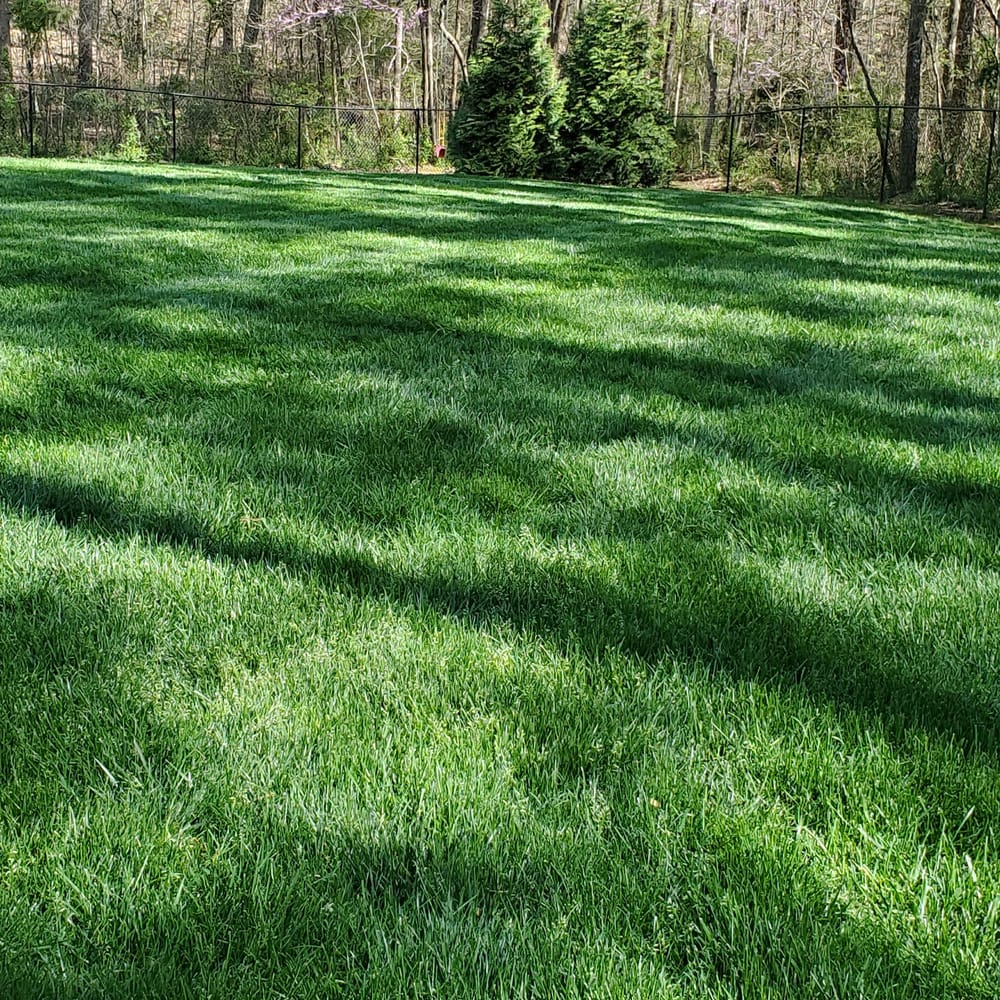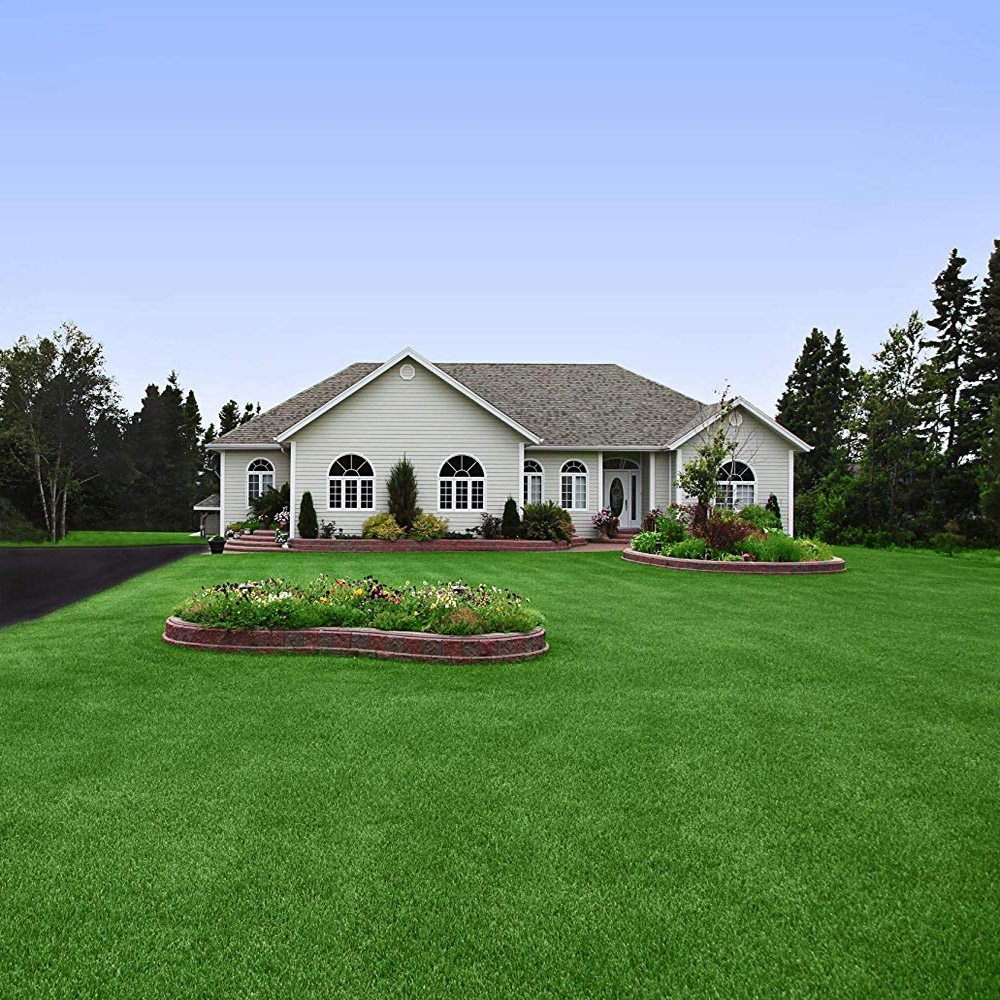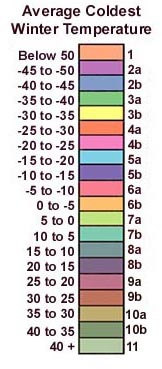
Kentucky Bluegrass - Midnight
- Dark Green Color
- Lawns
- Cost Efficient
Cool-Season Grasses:
Kentucky bluegrass - Kentucky bluegrass (Poa pratensis) is the most common type of grass used in Nevada. Cool season grasses characteristically endure cooler weather better than other types of grass. For instance, a Kentucky bluegrass lawn will stay green later in the season when temperatures begin to cool off. However, cool season grasses do not tolerate the heat of summer very well. If left to their own devices, cool season grasses will go dormant during the hottest months of the year.
Perennial ryegrass - Ryegrass is a persistent, dark-green, fine to medium-textured turfgrass that is used for home lawns, parks, grounds, golf courses, and athletic fields. This species produces a bunch-type growth habit and does not form rhizomes or stolons. Its recuperative potential is not as strong as Kentucky bluegrass. Perennial ryegrass germinates rapidly (5 to 7 days) and establishes quickly. It is very competitive with other turfgrasses and is used extensively for overseeding thin or damaged turf. Because of its aggressive nature, perennial ryegrass is generally not used in amounts over 20 percent in a mixture with other turfgrasses. It is suitable for use alone or in combination with Kentucky bluegrass and/or fine fescues.
Fine fescues - Fine Fescue is a shade tolerant turf grass with a medium to dark green color. Adapted to the Pacific Northwest, Fine Fescue grows best in cool humid regions, coastal regions and in high elevations. All varieties require little maintenance and like to be mowed at 1 1/2 to 2 1/2 inches. They have the finest leaves, the most shade tolerance and the lowest fertilizer, mowing and moisture requirements of all the cool season turf grasses. Chewings Fescue, Red Fescue, Creeping Red Fescue, Sheep Fescue and Hard Fescue are popular varieties of Fine Fescue. These varieties can be found on lawns, in parks, along road sides and other turf grass areas and extensively used in grass seed blends and mixes for both sunny and shady areas. Fine Fescues are not recommended for sports fields and golf tees because they have a low wear tolerance. Most of these varieties have all the same characteristics. Chewings Fescue has a noncreeping, bunch-type growth habit unlike Red Fescue. All varieties germinate rapidly and are well adapted to poor, dry, sandy soils.
Tall fescue - Turf Type - Tall Fescue is also a good general purpose turfgrass for Nevada. It often has greater heat tolerance and can tolerate more shade than Kentucky bluegrass. It also requires somewhat less irrigation. While older varieties were coarse in texture, most tall fescue varieties available today look very much like Kentucky bluegrass.Tall fescue is a persistent and durable plant that forms acceptable turf for home lawns, grounds, parks, playgrounds, and athletic fields. It is commonly used in low maintenance situations such as utility areas, highway medials, airstrips, and fairgrounds. Many new and improved varieties have finer texture, higher tiller densities, and a darker-green color than the coarse-textured, light-green varieties such as 'Kentucky 31' and 'Alta.' Tall fescue is considered by many individuals to be incompatible with the finer-textured and darker-green Kentucky bluegrass, perennial ryegrass, and fine fescues. Tall fescue may be objectionable in a mixture with fine-textured turfgrass species because it tends to form coarse-textured clumps in an otherwise uniform stand.
Tall fescue is primarily a bunch-type grass that occasionally produces short rhizomes. It is somewhat slow to establish extensive root systems and has only fair recovery potential. This species is the most heat and drought tolerant of the cool-season turfgrasses. The increased drought tolerance is a function of its ability to produce a deep root system. Tall fescue performs well in open, sunny areas and is moderately shade tolerant. It is less suited to heavily-shaded conditions than the fine fescues, but is more shade tolerant than Kentucky bluegrass and perennial ryegrass. Tall fescue is best suited to well-drained soils.
Warm-Season Grasses:
Buffalograss (Buchloe dactyloides). Is a warm season turf that can be planted in any area in Nevada, and it has many positive attributes. For instance, its color is a rich gray/blue that compliments many landscape plants. It does not grow very tall, making mowing completely optional. When it goes to seed, a quaint little bell-shaped seed head hangs from many of the stalks, making a decorative statement in your landscape. One drawback to Buffalograss - it’s not very cold tolerant. It takes longer in the spring to green up, and is among the first plants to go dormant in the fall. However, the dormant color of the Buffalograss is a uniform gold color- not the brown, dead looking color of dormant Kentucky bluegrass.
Warm season turfs are most common in Southern Nevada. These grasses include Bermudagrass (Cynodon dactlyon) and Zoysiagrass (Zoysia japonica). In and around the areas of Las Vegas most lawns are Bermuda grass. These grasses can tolerate the extremely warm temperatures common in Southern Nevada. Because these grasses are heat tolerant, they will not go dormant in the summer. However, because they are heat-loving grasses, warm season turfs have little tolerance for cold weather. A warm season grass will normally go dormant when temperatures begin to chill considerably. One beneficial aspect of warm season grasses is that they generally use less water than coolseason species.
| Click Name To View Grass Seed Choice | Type | Applications | |
|---|---|---|---|
| Bermuda Grass - Oasis |
|
Warm Season | Lawns - Full Sun - Fast Growing |
| Bermuda Grass - Blackjack |
|
Warm Season | Lawns - Full Sun - Fast Growing |
| Bermuda Grass - Yukon |
|
Warm Season |
Lawns - Golf Course - Fast Growing Full Sun - High End - Best Cold Tolerance |
| Bermuda Grass - Arden 15 |
|
Warm Season |
Lawns - Golf Course - Fast Growing Full Sun - High End |
| Buffalo Grass - Buffalo Supreme |
|
Warm Season | Lawns - High Drought Tolerance - Full Sun |
| Cool Season Mix - Showtime |
|
Cool Season |
Lawns - Moderate Shade Rye, Kentucky Bluegrass, Fine Fescue Mix |
| Cool Season Mix - Garland |
|
Cool Season |
Lawns - Moderate Shade Rye, Fine Fescue Mix |
| Fescue/Bluegrass Mix - Combat Extreme South |
|
Cool Season | Lawns - Wear Tolerant - Extra Heat Tolerance |
| Fescue Blend - Combat Extreme Transition |
|
Cool Season | Lawns - Wear Tolerant |
| Fine Fescue Blend - Legacy |
|
Cool Season | Lawns - Moderate to Dense Shade |
| Kentucky Bluegrass - Bluegrass Supreme |
|
Cool Season | Lawns - Golf Gourses - Full Sun |
| Kentucky Bluegrass - Midnight |
|
Cool Season | Lawns - Golf Courses - Full Sun |
| OSP Ryegrass |
|
Cool Season | Lawns - Golf Courses |


Below is the USDA Zone Map for Nevada so you can determine which zone you reside in. Below that are our picks for your state which will do best in your area. Next on this page are tables which list various grasses and their characteristics so you can compare before you decide on your purchase. Click on the product name (ie. Midnight) for more information about that grass and to make your purchase.
| USDA Zone Map For Nevada | |
|---|---|
 |
 |
| Compare Various Grasses For Their Characteristics | ||||||||
|---|---|---|---|---|---|---|---|---|
| Cool Season Grasses |
Leaf Texture |
Establish Rate |
Nitrogen Use |
Water Use |
Drought Tolerance |
Salinity Tolerance |
Shade Tolerance |
|
| Bluegrass - Kentucky | Moderate to Fine |
Slow | Moderate to High |
Moderate to High |
Good | Moderate | Poor | |
| Bluegrass - Rough | Moderate to Fine |
Slow | Moderate to High |
Moderate to High |
Poor | Moderate | Excellent | |
| Fescue - Hard | Fine | Slow to Moderate |
Low to Very Low |
Moderate | Excellent | Low to Moderate |
Excellent | |
| Fescue - Creeping | Fine | Moderate | Low to Moderate |
Moderate | Good | Low | Excellent | |
| Fescue - Turf Type | Moderate to Coarse |
Moderate | Moderate to High |
Low to Moderate |
Excellent | Low | Good to Excellent |
|
| Ryegrass - Perennial | Fine to Moderate |
Very Fast | Moderate to High |
Moderate to High |
Good | Poor to Moderate |
Poor to Moderate |
|
| Warm Season Grasses |
Leaf Texture |
Establish Rate |
Nitrogen Use |
Water Use |
Drought Tolerance |
Salinity Tolerance |
Shade Tolerance |
|
| Bermudagrass | Fine to Moderate |
Moderate to Fast |
Moderate | Moderate to High |
Excellent | Very Good | Poor | |
| Buffalograss | Moderate to Coarse |
Slow to Moderate |
Low | Low | Excellent | Moderate | Very Poor | |
| Compare Various Grasses For Their Characteristics - Continued | ||||||||
|---|---|---|---|---|---|---|---|---|
| Cool Season Grasses |
Fertility Needs |
Wear Resistance |
Mowing Height |
Cold Tolerance |
Acid Soil Tolerance |
Thatching Tendency |
Heat Tolerance |
|
| Bluegrass - Kentucky | Medium | Medium to High |
Medium | High | Medium | Medium | Medium | |
| Bluegrass - Rough | Medium | Medium | Medium | High | Medium | Medium | Medium | |
| Fescue - Hard | Low | Low | Medium | Medium to High |
Medium to High |
Low to Medium |
Low to Medium |
|
| Fescue - Creeping | Low | Low | Medium | High | Medium to High |
Low to Medium |
Low to Medium |
|
| Fescue - Turf Type | Low to Medium |
Medium to High |
Medium to High |
Medium | High | Low | High | |
| Ryegrass - Perennial | Medium | High | Low to Medium |
Medium | Medium | Low | Medium to High |
|
| Warm Season Grasses |
Fertility Needs |
Wear Resistance |
Mowing Height |
Cold Tolerance |
Acid Soil Tolerance |
Thatching Tendency |
Heat Tolerance |
|
| Bermudagrass | Medium | High | Low to Medium |
Low to Medium |
Medium | Medium | High | |
| Buffalograss | Low | Low | High | High | Low | Low | High | |